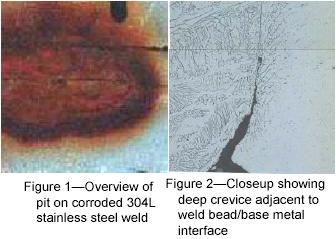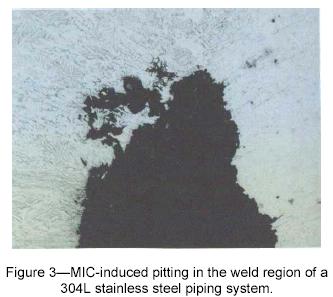Microbial Corrosion Of Stainless Steel – Austral Wright Metals
 |
Application Data Sheet – Stainless Steel Microbial Corrosion |
Microbiologically Corrosion Failure Analysis of 304L Stainless Steel |
Susan Borenstein Aptech Engineering Services Houston, Texas AbstractAn AISI Type 304L stainless steel piping system failed due to microbial corrosion or microbiologically influenced corrosion (MIC) after being in contact with stagnant, low chloride potable water for nine months. This report discusses this failure and uses it to illustrate common problems associated with microbial corrosion in piping systems and other equipment. Introduction to Microbial Corrosion of Stainless SteelThe term microbiologically influenced corrosion is used to designate corrosion resulting from the presence and activities of microorganisms within biofilms. Microbiologically influenced corrosion is often misdiagnosed as an attack caused by conventional chloride crevice/pitting corrosion. The corrosion literature contains numerous articles in the past few years describing costly pitting failures of austenitic stainless steel components. The austenitic stainless steel microbial corrosion failures are often characterized by rapid failure rates with extremely localised attack at weld regions. Although stainless steel is subject to localised crevice corrosion in chloride bearing waters, the relatively low chloride concentration of some waters combined with the rapid failure rates does not fit classical stainless steel crevice corrosion. The cooling water system was an all-welded design constructed of AISI Type 304L stainless steel piping and was designed to operate with corrosion-inhibited water in a closed-loop mode servicing a series of heat exchangers. During construction (Phase 1) the system was successfully hydrotested with city water (potable). Due to construction scheduling errors, the hydrotest water was not drained before the Phase 1 piping system was put into lay-up. Numerous pipe leaks associated with welded regions were detected during a re-hydrotest after a nine-month lay-up. Phase II piping system components, which were subjected to only two months of lay-up in the same city water also exhibited corrosion in welded regions. The system was constructed in two phases; Phase 1 construction was completed and hydrotested with city drinking water in January 1998. Phase 2 was completed, joined to the Phase 1 piping and hydrotested with city water in September 1999. At that time failures due to through-wall pitting were discovered in the Phase 1 piping. At that time it was realized that Phase 1 was put into lay-up while full of hydrotest water and not drained and dried as planned. Microbiologically Influenced Corrosion ExperimentA failure analysis was performed. Internal inspection found 12 locations of pitting at or adjacent to welds in the Phase 1 piping system. Radiography was performed to confirm the locations. Water samples were taken from both Phase 1 and Phase 2 systems, following the failed hydrotesting. The city water contained very low chlorides, approximately 86 ppm nominal and 25 ppm from samples removed at the time of failure. The source of the city water is a combination of surface and well water. Microbiological analysis found corrosion-related microbes, including iron bacteria in the water. Several areas were selected for metallurgical examination. Figures 1-3 show the results of this examination. The morphology of the pits found in the stainless steel were jagged, a characteristic of MIC but not of more conventional crevice corrosion in stainless steel.
Although the Phase 2 system was drained when the hydrotesting found leaks due to through-wall pitting, it was not drained dry, and some water remained stagnant. After approximately two months stagnant exposure to city water, this situation was discovered and additional inspection was performed. Inspection revealed shallow pitting had occurred in the Phase 2 system. Microbial Corrosion Experient DiscussionIt is well known that microbially influenced corrosion commonly results when residual water is left in stainless steel systems after hydrostatic testing. Natural waters, particularly well water, contain several classes of microorganisms, which can develop a biofilm in moist environments and accelerate metal corrosion. The corrosion is in the form of selective phase attack resulting in corrosion pits in HAZ and weld zones. The failure rates are often rapid (in terms of weeks or months) and frequently occur in waters with low chloride concentrations (less than 100 ppm). In this case pitting corrosion failures due to MIC occurred in approximately nine months, because the system had been allowed to sit stagnant with biologically active, but low-chloride, water. While the failure analysis was being performed for the Phase I system pitting failures, the Phase 2 system was inadvertently only partially drained. Inspection was immediately performed on the Phase 2 system. Inspection revealed shallow pitting had occurred in the Phase 2 system after approximately two months stagnant exposure to city water. A root cause failure analysis found MIC as the cause of the pitting. SummaryThis report on microbial corrosion illustrates the following:
|


